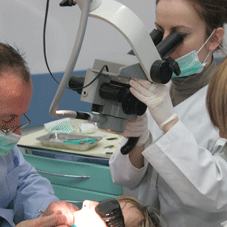Nowadays, we can treat and save many teeth that have been doomed to extraction before.
This is possible thanks to a modern endodontic therapy (root canal treatment). An endodontic treatment is time-consuming, requires outstanding skills and modern equipment.
Root canal treatment explained simply involves the removal of infected or dead pulp from the pulp chamber and root canal system of teeth, mechanical and chemical clean-up, and finally sealing it using filling materials specially developed for that purpose.
To make sure that the tooth is not penetrated by bacteria from saliva or not irritated by rinsing agent, a dental dam is installed on a treated tooth. Key to the success of root canal therapy is the mechanical and chemical clean-up and the widening of root canals all throughout their length. This is possible thanks to specially designed and constantly improved tools. In our practice we use tools made of nickel-titanium alloys, which are highly flexible and therefore allow clean-up of even very curved and narrow canals. The mechanic clean-up of the root canal system is supported by their extensive rinsing. These procedures are designed to disinfect and clean-up the entire canal system. The length of the canals is accurately measured using the endometer (an electronic device that measures the length of the canals – Raypex 5) and X-Ray images.
Invaluable in endodontic treatment is a dental microscope. By using this device we can locate a number of canals that are invisible to the naked eye. Such omissions are the most common cause of the treatment failure. The microscope allows to look inside the canal, locate and remove broken tools or to clear a narrow root canal. After the clean-up, the root canals are carefully filled.
During and at the end of the treatment it is necessary to take a few X-Ray images. In particularly difficult cases we are also able to take 3D images, which allows to obtain a very precise information about the root canal layout.
The final stage of the therapy is to restore the tooth. We can both rebuild the tooth crown using composite materials, or if so happens that the crown is damaged, we insert a prosthetic crown.
Professional root canal treatment requires time and patience, which means that it is rarely finished in one visit.
This is possible thanks to a modern endodontic therapy (root canal treatment). An endodontic treatment is time-consuming, requires outstanding skills and modern equipment.
Root canal treatment explained simply involves the removal of infected or dead pulp from the pulp chamber and root canal system of teeth, mechanical and chemical clean-up, and finally sealing it using filling materials specially developed for that purpose.
To make sure that the tooth is not penetrated by bacteria from saliva or not irritated by rinsing agent, a dental dam is installed on a treated tooth. Key to the success of root canal therapy is the mechanical and chemical clean-up and the widening of root canals all throughout their length. This is possible thanks to specially designed and constantly improved tools. In our practice we use tools made of nickel-titanium alloys, which are highly flexible and therefore allow clean-up of even very curved and narrow canals. The mechanic clean-up of the root canal system is supported by their extensive rinsing. These procedures are designed to disinfect and clean-up the entire canal system. The length of the canals is accurately measured using the endometer (an electronic device that measures the length of the canals – Raypex 5) and X-Ray images.
Invaluable in endodontic treatment is a dental microscope. By using this device we can locate a number of canals that are invisible to the naked eye. Such omissions are the most common cause of the treatment failure. The microscope allows to look inside the canal, locate and remove broken tools or to clear a narrow root canal. After the clean-up, the root canals are carefully filled.
During and at the end of the treatment it is necessary to take a few X-Ray images. In particularly difficult cases we are also able to take 3D images, which allows to obtain a very precise information about the root canal layout.
The final stage of the therapy is to restore the tooth. We can both rebuild the tooth crown using composite materials, or if so happens that the crown is damaged, we insert a prosthetic crown.
Professional root canal treatment requires time and patience, which means that it is rarely finished in one visit.






